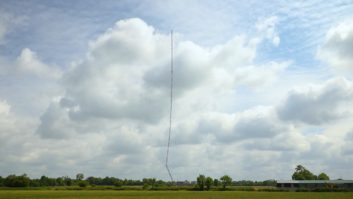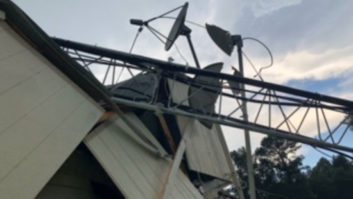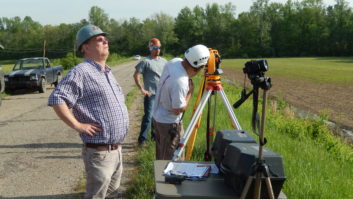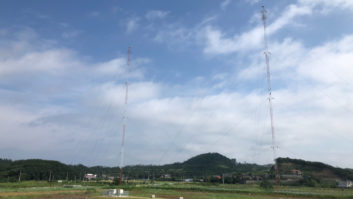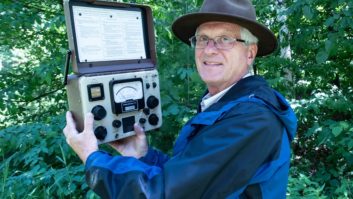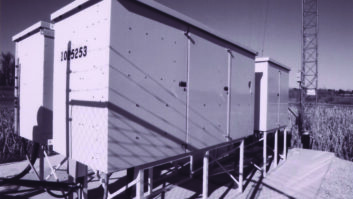Cox San Antonio Market engineer Paul Reynolds took the picture in Fig. 1 of one of his towers. This is a 370-foot Rohn, heavily loaded. Wind was light; maybe 5 to 7 mph is Paul’s guess.

Fig. 1: You don’t want to learn the answer to the question in our headline the hard way. Never leave a contractor unsupervised. The station had leased space on the tower to a cellular carrier, which contracted with a “tower company” to do some structural things, mainly replace guy cables and install new anchors. Well, it turns out that the “tower company” in turn subbed the job to another “tower company.”
So Paul showed up that afternoon to see what was going on. He noticed the second tier of guy cables hanging with no temporary cables installed. He called up, “Where are the temps?” The crew chief yelled back, “Who in the [expletive] are you?” Things kind of went downhill from there.
The man was relieved of duty the next day, and the tower company put up temps for the remaining levels of guy cable changes.
Paul writes that it’s idiots like this who cause accidents. It was a miracle two men weren’t killed and a tower felled in the process.
Paul, thanks for sharing this nightmare and reminding readers to supervise the work of site contractors no matter what they are doing.
I recall that a few years ago, a roofing contractor was re-tarring the roof of a transmitter building. The chief just happened to be inside as the tar started pouring down the inside wall of the building. He caught it before any major damage was done.
Another station was not so lucky. Its phasor was ruined when roofing tar leaked over the edge of the transmitter building roof and followed the coax lines into the equipment.
Both of these cases involved reputable companies — let’s face it, accidents will happen — but the chance of problems is minimized if you are on site supervising the work.
* * *
Nassau Broadcasting’s Bill Ryall, director of engineering for the group’s Maine cluster of stations, read the comments in Workbench about rodent problems.
In areas with snowy winters and mountaintop sites, many engineers use ATVs, snowmobiles or other engine-powered methods to get to their transmitters. Often these vehicles are kept outdoors or in non-sealed, non-climate controlled structures.
Remember that rodents love warm engine blocks. They also have a tendency to crawl into air intakes and build nests, especially if the engine isn’t run regularly.
Bill has a snowmobile in the shop getting the top end of its engine rebuilt after damage caused by a hidden mouse nest that restricted airflow on the air-cooled engine. That’s not a good situation should transmitter problems develop and you have no other way to get to the site. Worse, what if the machine dies, leaving you stranded miles from civilization? Remember that survival safety checklist?
Rodents will crawl into truck engine compartments, and they’ll nest in the computer control enclosure of gensets. They also love to chew the plastic off wiring. That makes for a mess on both counts. All a mouse needs is an opening the size of a dime.
Use mothballs and clothes drier fabric softener sheets as repellents. Just remember to change them regularly to keep them fresh. If you stuff them into the air vents of a snowmobile engine, remove them before you start it up.
Yet one more thing to check when visiting a transmitter site. …
* * *
Springtime is “home show” time. At a recent expo in New Hampshire I discovered an inexpensive yet sturdy device to hang things from wooden studs.

Fig. 2: The Stud Grabber is ideal for holding coax. Stud Grabber instant storage clips will hold up to 25 pounds. The unique design securely grabs onto a 2×4. The Stud Grabber has sharpened spike-like prongs that dig into the wooden stud, effectively securing the bracket.
Made by Waylin Products, Stud Grabbers come in a variety of sizes. I liked the one shown in Fig. 2 because 3-inch coax would lie nicely in the cup formed by the heavy wire. Many transmitter “shacks” use wooden storage buildings, so you might find these useful.
You can find out more at www.studgrabber.com. Google “studgrabber” to find a variety of online distributors.
* * *
If you’re heading to the NAB Show next month, perhaps I’ll see you there. It’s readers like you who make this column, and this publication, so successful. Thank you for contributing and reading Radio World!
John Bisset marked his 40th year in radio in broadcasting recently. He works for Tieline Technology and is a past recipient of the SBE’s Educator of the Year Award. Reach him at [email protected] or (603) 472-5282. Faxed submissions can be sent to (603) 472-4944.
Submissions for this column are encouraged and qualify for SBE recertification credit.






